How content templates can help you improve productivity
Remove ambiguity and speed up production
Ditch unruly shared documents and give contributors structure to produce the content you need.
- Structure templates to match any format
So edits aren’t required when you publish - Create content rules
Speeding up your approval process - Embed style guidelines
To keep your content on-brand - Build a template library
Saving time as your content creation scales

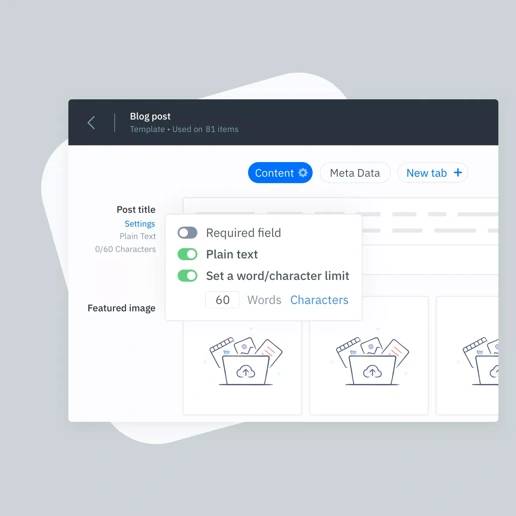

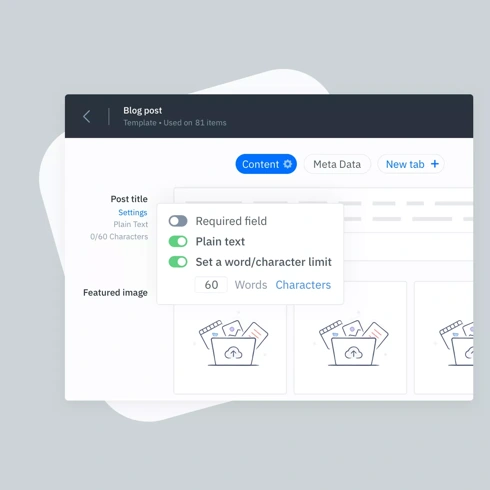
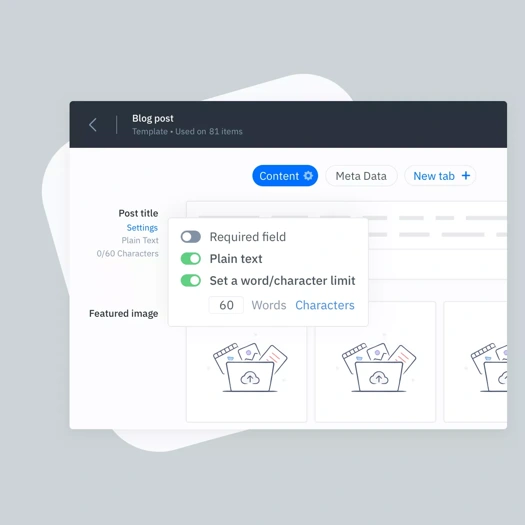
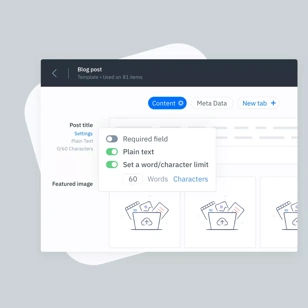
Flexible templates for multi-channel production
Create a central library so that your team don't waste time jumping between platforms to create content. Here's just a few examples of content types you can create templates for:
- Website
- Social
- Blog
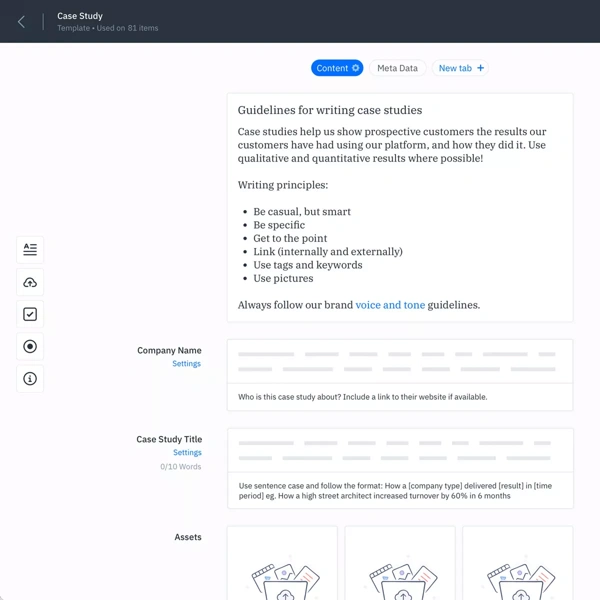
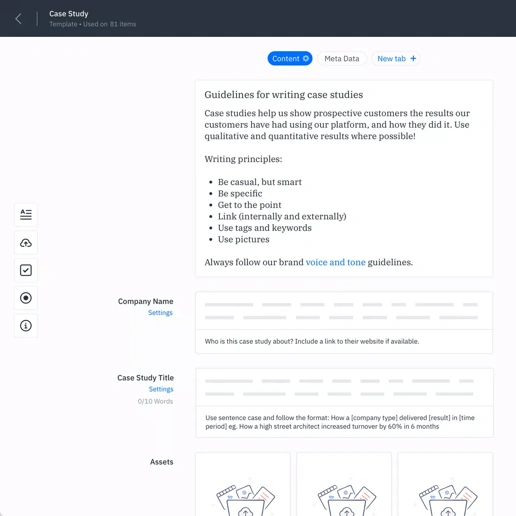

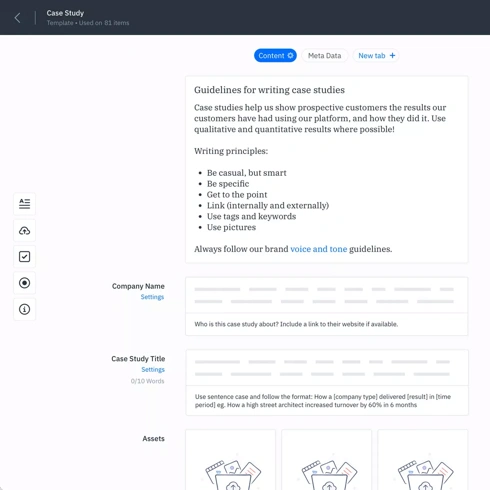
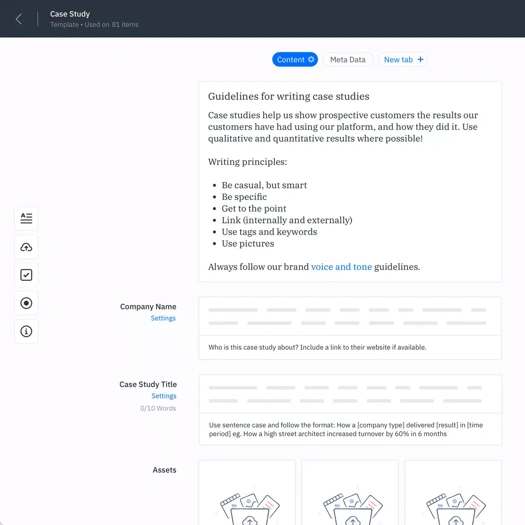
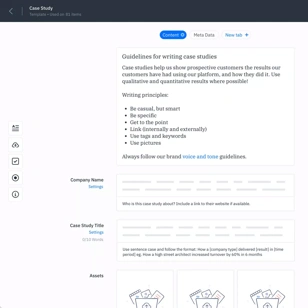
What are content templates?
A content template is a document that makes it easy to create content in a structured way.
Big content projects—the kind with lots of contributors, subject matter experts, and stakeholders—can get messy.
Multiple writers across different departments, subject matter experts without a writing background, and writers without subject matter expertise. You’re wrangling legal teams, SEO specialists, content creators, and content distributors. And, to top it all off, everyone is sending/saving/uploading content that's formatted differently.
It can be chaos. This is why so many companies rely on website content templates to keep everyone on the same page.
Content templates to the rescue
Templates are essential to the content creation process, especially if you have more than one 'cook in the content marketing kitchen.'
Templates also help your team think strategically and holistically about the content they’re creating for each page.
How can your templates accomplish all this? By incorporating the right elements—for strategic thinking, SEO-friendliness, usability, and, of course, on-page content itself…
Top three elements of website content templates
There are a few important elements that must be included in any content template. Here are the top 3 you need to make sure your templates include:
1. Strategic elements
These strategic elements will help your content creation team stay focused on company goals, user goals, and the content that supports them.
If you already have page tables, consider incorporating them into your templates.
(Page tables are strategic breakdowns of each page of your site and may include page goals, prioritized content, and maintenance concerns. If you want to learn more, we recommend picking up a copy of Content Strategy for the Web by Kristina Halvorson and Melissa Rach.)
If you are creating templates from scratch, make sure to include strategic elements from the start. And if you’ve got a template without strategic elements, it’s time to weave them in.
Here are a few elements you may want to include in your templates:
Maintenance considerations
- How often should this content be updated?
- Does it have an expiration date?
- Are there any time-sensitive numbers or info on the page?
Audience
- If you have multiple audiences for your site, which audience is this page targeted at primarily?
- Is there a secondary audience that may click on this page as well?
Purpose
- In one sentence, describe what this page is trying to accomplish.
- What do you want your audience to walk away with?
Keyword research
- What keywords need to be incorporated on the web page?
- Are there any guidelines for including these keywords?
Audience questions
- What questions are your users trying to answer by coming to this page?
- What questions will you answer in the piece of content?
Technical considerations
- Does any additional technology need to be developed or included on this page?
Phase two content
- Is there anything that needs to be added to this page at a later date? Why and when?
- What additional supporting content should be linked to this page or added to this section when phase two budget or goals kick in?
CTA
- What call to action must be included on this page?
- Where will the CTA link to?
2. SEO and usability elements
In addition to audience, purpose, and strategy, you need to account for SEO and usability upfront by including them in your templates. SEO and usability elements, which so often go hand in hand, may include:
- Keywords to focus on
- Meta descriptions
- Browser titles
- ALT and TITLE tags
- Friendly URLs
- Literacy levels/scores
- Technical requirements (“put a pause button on this page’s scrolling content,” for example)
Even if you aren’t focused on SEO, it’s always a good idea to include usability elements, as well as browser titles and meta descriptions, which impact users as well as search engines.
3. On-page content elements
Make sure you don’t forget the on-page content (which, if you already have templates, is probably what you’re starting with). With predetermined templates, you can make sure that your content writers not only address the headline and body copy for each page, but also:
- Images, graphics, and video
- Sidebar items
- Link lists
- PDFs and other downloads
- Podcasts
- Infographics
- Forms (including form fields, required fields, and intro language)
Depending on your project, you may want to include some or all of these elements—or you may want to have several different content templates for different sections of the site. For example, a video library will have different content requirements than a landing page, though both can benefit from the strategic and SEO elements discussed above).
Three types of website content templates
Beyond a template for the web content itself, you may also want to use a template to help with the strategic planning process for developing new content. Here are a few templates you can use:
1. Website content outline template
Using a website content outline template helps ensure that you’re including everything you need on your page from both a content and SEO perspective.
Like other content writing templates, the contents of this template will depend on the type of content and topic.
In general, your website content outline will include:
- Headline
- Sub-headline
- Headers
- Sub-headers
- Paragraphs
- Bullet points
- Calls-to-action
This content template will help you save time every time you create a new web page. All you have to do is fill in the information and publish it. Not only will it save you time but it will also ensure that every new page that’s created is consistent.
Ready to outline your content for the web? Get our free content project brief, which you can use to plan and outline each web page.
2. Website content planning template
While the website content outline template helps you plan the content on each page, the website content planning template allows you to plan the website content for the entire site.
This is an essential part of not only web design but also a strategic approach to website copy.
Your website content planning template should include:
- Home page
- About page
- Services or Products page
- Contact
- Blog
You’ll also include any other pages that are essential to helping others understand your offers. This might be individual service or product pages or perhaps pillar pages meant to educate visitors on important topics in your industry.
3. Website content audit template
Editing your website content can be overwhelming when you first get started, especially if you’ve never done a content audit before.
However, by keeping an updated list of site content that you periodically update, you can make sure there are no gaps in your content needs.
Your website content audit template will include:
- Page title (H1)
- Title tag
- Meta description
- URL
- Keywords
- CTA
- Internal links
- External links
You can add whatever elements are important to you to your website content audit template. If you’re blogging regularly, be sure to add these posts to the audit as well so you can more easily find link opportunities.
Where to create and save your content templates
Now that you have an idea about what to include in your content templates, let’s talk about content management as it pertains to templates.
You can use a tool like Google Docs to create, collaborate, and manage templates.
However, there are some specific benefits to using a tool that’s built for content operations—like GatherContent. GatherContent offers a range of content templates that help you structure your content, which becomes increasingly more important as you scale content production.
See what Bynder can do for you
Our in-house experts can walk you through everything you need to know.
Book a demo Start 14-day Content Workflow trial